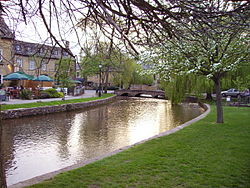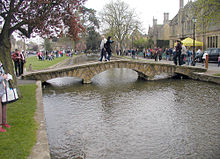River Windrush
| Windrush | |
|---|---|
 The Windrush at Bourton-on-the-Water | |
 | |
| Location | |
| Country | England |
| Counties | Gloucestershire, Oxfordshire |
| Towns | Bourton-on-the-Water, Burford, Witney |
| Physical characteristics | |
| Source | |
| • location | Gloucestershire, Cotswold Hills |
| • coordinates | 51°58′54.51″N 1°51′59.64″W / 51.9818083°N 1.8665667°W |
| Mouth | River Thames |
• location | Newbridge |
• coordinates | 51°42′36.03″N 1°25′7.19″W / 51.7100083°N 1.4186639°W |
| Length | 65 km (40 mi) |
| Discharge | |
| • location | Newbridge |
| • average | 3.27 m3/s (115 cu ft/s) |
| • minimum | 0.11 m3/s (3.9 cu ft/s)26 August 1976 |
| • maximum | 21.6 m3/s (760 cu ft/s)6 December 1960 |
| Discharge | |
| • location | Worsham |
| • average | 2.40 m3/s (85 cu ft/s) |
| Discharge | |
| • location | Bourton-on-the-Water |
| • average | 1.20 m3/s (42 cu ft/s) |
 | |
The River Windrush is a tributary of the River Thames in central England. It rises near Snowshill in Gloucestershire and flows south east for 65 km (40 mi) via Burford and Witney to meet the Thames at Newbridge in Oxfordshire.
The river gives its name to the village of Windrush in Gloucestershire.
River
[edit]The Windrush starts in the Cotswold Hills in Gloucestershire northeast of Taddington, which is north of Guiting Power, Temple Guiting, Ford and Cutsdean. It flows for about 35 miles (56 km): through Bourton-on-the-Water, by the village of Windrush, Gloucestershire, into Oxfordshire and through Burford, Witney, Ducklington and Standlake. It meets the Thames at Newbridge upstream of Northmoor Lock.
The river-name Windrush is first attested in an Anglo-Saxon charter of 779, where it appears as Uuenrisc. It appears as Wenris and Wænric in charters of 949, and Wenríc in one of 969. The name means 'white fen', from the Welsh gwyn and the Old Celtic reisko.[1]
The river may still host trout, grayling, perch, chub, roach and dace. It held good populations of native crayfish until at least the 1980s. Its waters were used in cloth and woollen blanket making in Witney from mid 17th century.[2] In 2007, it was among many of the district's rivers to flood. It flooded generally but perhaps most acutely in Witney, whose only bridge across the river was submerged.[3] Some decline has been noted, especially in years of release of untreated sewage from plants of Thames Water.[4][5] The river after drier spells sees algae formations.[6][7]
The ship HMT Empire Windrush, synonymous with postwar immigration of West Indian people to the UK, was named after the river.[8]
See also
[edit]
References
[edit]- ^ Eilert Ekwall, The Concise Oxford Dictionary of English Place-names, p.523.
- ^ "history Witney Blanket Story – A brief history of the wool trade in the Witney area". Archived from the original on 23 July 2011. Retrieved 17 December 2009.
- ^ "Witney Flood Gallery". Archived from the original on 30 September 2008. Retrieved 17 December 2009.
- ^ Rice, Liam (27 November 2019). "Thames Water asked to tackle sewage pollution in Windrush". Oxford Mail. Archived from the original on 28 November 2019. Retrieved 1 September 2020.
- ^ Lane, Ellis (26 January 2020). "'Raw untreated sewage' is flowing into Cotswolds river". Gloucestershire Live. Archived from the original on 27 May 2020. Retrieved 1 September 2020.
- ^ "River Windrush, Barrington, Gloucestershire" (PDF). The Wild Trout Trust. Archived (PDF) from the original on 1 September 2020. Retrieved 1 September 2020.
- ^ Freeman, Anna (2019). River phytoplankton biological controls on a microscopic level (PDF) (Thesis). University of Reading. Archived (PDF) from the original on 1 September 2020. Retrieved 1 September 2020.
- ^ "HMT Empire Windrush". Windrush Review. June 2020. Archived from the original on 1 September 2020. Retrieved 1 September 2020.


 French
French Deutsch
Deutsch